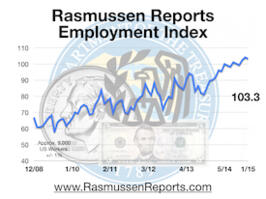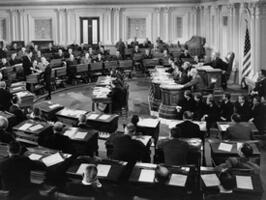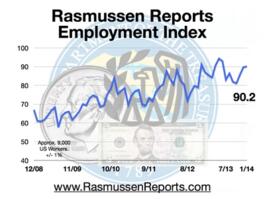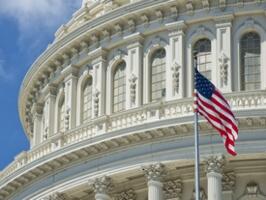45% Say U.S. Heading in Right Direction
Forty-five percent (45%) of Likely U.S. Voters think the country is heading in the right direction, according to a new Rasmussen Reports national telephone and online survey for the week ending March 2.
Search for "January 6"
Site search returned 222 matches
Sort results by

Forty-five percent (45%) of Likely U.S. Voters think the country is heading in the right direction, according to a new Rasmussen Reports national telephone and online survey for the week ending March 2.

President-elect Donald Trump’s inauguration is still one day away, even though he officially won the presidency more than two months ago. But voters don’t seem to mind the wait.

A post-convention bounce appears to have given Democratic presidential nominee Hillary Clinton her biggest lead over Republican rival Donald Trump since June in our latest weekly White House Watch survey. This is the first update that includes both the Libertarian and Green Party candidates.

Voters give mixed marks to this year’s primaries and candidate debates, but a sizable number say they’ve changed horses since the first of the year.

The Rasmussen Employment Index which measures worker confidence slipped a point in January following two months in a row of six-year highs.
At 103.3, worker confidence is down from December’s 104.2. The index fell to a recent low of 81.2 in October 2013 but gained steadily after that. After the Wall Street meltdown in the fall of 2008, the index fell dramatically, hitting an all-time low of 57.8 in July 2009.
(Want a free daily e-mail update? If it's in the news, it's in our polls). Rasmussen Reports updates are also available on Twitter or Facebook.
The survey of 9,364 working Americans was conducted in January 2015 by Rasmussen Reports. The margin of sampling error is +/- 1 percentage points with a 95% level of confidence. Field work for all Rasmussen Reports surveys is conducted by Pulse Opinion Research, LLC. See methodology.

When tracking President Obama’s job approval on a daily basis, people sometimes get so caught up in the day-to-day fluctuations that they miss the bigger picture. To look at the longer-term trends, Rasmussen Reports compiles the numbers on a full-month basis, and the results can be seen in the graphics below.
The president earned a monthly job approval of 49% in January. That’s up a point from December and up two points from the three months prior. It also ties Obama’s high for 2014 reached in February and May. His monthly approval hit a two-year low of 45% in November 2013 during the troubled rollout of the new national health care law.
(Want a free daily e-mail update? If it's in the news, it's in our polls). Rasmussen Reports updates are also available on Twitter or Facebook.
Daily tracking results are collected via telephone surveys of 400 likely voters per night. The monthly numbers in this article are based on approximately 12,000 interviews each month with likely voters. The margin of sampling error is less than +/- 1 percentage points with a 95% level of confidence.

As Congress heads off on a five-week recess, voters continue to express a very low opinion of the legislators they elect.
A new Rasmussen Reports national telephone survey finds that just six percent (6%) of Likely U.S. Voters think Congress is doing a good or excellent job, while 63% rate its performance as poor. (To see survey question wording, click here.)
(Want a free daily e-mail update? If it's in the news, it's in our polls). Rasmussen Reports updates are also available on Twitter or Facebook.
The survey of 1,000 Likely Voters was conducted on July 29-30, 2014 by Rasmussen Reports. The margin of sampling error is +/- 3 percentage points with a 95% level of confidence. Field work for all Rasmussen Reports surveys is conducted by Pulse Opinion Research, LLC. See methodology.

Congress earns its lowest performance ratings in months, while fewer voters than ever think members of Congress actually listen to them.
A new Rasmussen Reports national telephone survey finds that just six percent (6%) of Likely U.S. Voters think Congress is doing a good or excellent job, its lowest positives since last June. Sixty-three percent (63%) rate Congress' job performance poorly. Still, that's down 12 points from an eight-year high of 75% last November amidst the troubled rollout of the new national health care law. (To see survey question wording, click here.)
(Want a free daily e-mail update? If it's in the news, it's in our polls). Rasmussen Reports updates are also available on Twitter or Facebook.
The survey of 1,000 Likely Voters was conducted on April 15-16, 2014 by Rasmussen Reports. The margin of sampling error is +/- 3 percentage points with a 95% level of confidence. Field work for all Rasmussen Reports surveys is conducted by Pulse Opinion Research, LLC. See methodology.

Few Americans consider St. Patrick’s Day an important holiday, but adults under 40 are much more likely to celebrate it than their elders.
A new Rasmussen Reports national telephone survey finds that just six percent (6%) of American Adults consider St. Patrick’s Day one of our nation’s most important holidays, while 57% consider it one of the least important. Thirty-four percent (34%) consider today's holiday somewhere in between the two. (To see survey question wording, click here.)
(Want a free daily e-mail update? If it's in the news, it's in our polls). Rasmussen Reports updates are also available on Twitter or Facebook.
The survey of 1,000 Adults was conducted on March 13-14, 2014 by Rasmussen Reports. The margin of sampling error is +/- 3 percentage points with a 95% level of confidence. Field work for all Rasmussen Reports surveys is conducted by Pulse Opinion Research, LLC. See methodology.

The Rasmussen Employment Index which measures worker confidence rose less than half a point in January, just barely continuing the upward trend it began in November.
At 90.2, worker confidence is still at its highest level since June but is down five points from the all-time high of 94.4 in May of last year. The index hit a low for 2013 of 81.2 in October. It stood at 87.1 in January 2013.
Generally speaking, an increase in the Rasmussen Employment Index suggests the upcoming government report on job creation will be stronger than the prior month’s report.
(Want a free daily e-mail update? If it's in the news, it's in our polls). Rasmussen Reports updates are also available on Twitter or Facebook.
The survey of 9,060 working Americans was conducted in January 2014 by Rasmussen Reports. The margin of sampling error is +/- 1 percentage points with a 95% level of confidence. Field work for all Rasmussen Reports surveys is conducted by Pulse Opinion Research, LLC. See methodology.

When tracking President Obama’s job approval on a daily basis, people sometimes get so caught up in the day-to-day fluctuations that they miss the bigger picture. To look at the longer-term trends, Rasmussen Reports compiles the numbers on a full-month basis, and the results can be seen in the graphics below.
The president’s total job approval rose a point to 48% in January. That’s up from 45% in November, the president’s lowest monthly approval in two years, but still down eight points from December 2012’s recent high of 56%. The president's rating took a hard hit in November from the problems surrounding the rollout of the new national health care law but gained two points by the end of the year. Through much of November and early December, Obama’s daily job approval ratings were at the lowest levels of his entire presidency.
(Want a free daily e-mail update? If it's in the news, it's in our polls). Rasmussen Reports updates are also available on Twitter or Facebook.

April 15 will be here soon, and roughly half of Americans believe they pay more than their fair share in taxes.

Most Americans don't consider it a very important holiday, but many plan to keep the New Year’s Eve celebrations going right on through New Year’s Day.
A new Rasmussen Reports national telephone survey finds that just six percent (6%) of American Adults rate New Year’s Day one of the nation’s most important holidays, while 34% view it as one of the least important. Most (55%) see it as somewhere in between. (To see survey question wording, click here.)
(Want a free daily e-mail update? If it's in the news, it's in our polls). Rasmussen Reports updates are also available on Twitter or Facebook.
The survey of 1,000 American Adults was conducted on December 30, 2013 by Rasmussen Reports. The margin of sampling error is +/- 3 percentage points with a 95% level of confidence. Field work for all Rasmussen Reports surveys is conducted by Pulse Opinion Research, LLC. See methodology.

Both sides insist a budget deal is near that will avoid another federal government shutdown, but most voters still want budget cuts and remain skeptical that such a deal is coming.
Just 12% of Likely U.S. Voters favor a federal budget that increases government spending, according to a new Rasmussen Reports national telephone survey. Fifty-six percent (56%) prefer a long-term budget deal that cuts spending instead. Twenty-five percent (25%) want to keep federal spending about the same. (To see survey question wording, click here.)
(Want a free daily e-mail update? If it's in the news, it's in our polls). Rasmussen Reports updates are also available on Twitter or Facebook.
The survey of 1,000 Likely Voters was conducted on December 6-7, 2013 by Rasmussen Reports. The margin of sampling error is +/- 3 percentage points with a 95% level of confidence. Field work for all Rasmussen Reports surveys is conducted by Pulse Opinion Research, LLC. See methodology.

Most voters want a long-term budget deal that cuts federal spending but expect another government shutdown soon because Congress can’t reach such a deal.
Just 15% of Likely U.S. Voters favor a federal budget that increases spending, according to a new Rasmussen Reports national telephone survey. Fifty-four percent (54%) prefer a budget that cuts spending instead, while 25% want one that keeps spending levels about the same. (To see survey question wording, click here.)
(Want a free daily e-mail update? If it's in the news, it's in our polls). Rasmussen Reports updates are also available on Twitter or Facebook.
The survey of 1,000 Likely Voters was conducted on October 18-19, 2013 by Rasmussen Reports. The margin of sampling error is +/- 3 percentage points with a 95% level of confidence. Field work for all Rasmussen Reports surveys is conducted by Pulse Opinion Research, LLC. See methodology.

Positive assessments of Congress’ job performance remain in single digits again this month, and they’re not thrilled with their own representative either.
Only six percent (6%) of Likely U.S. Voters give Congress good or excellent marks for the job it is doing, according to a new Rasmussen Reports national telephone survey. Sixty-four percent (64%) rate its performance as poor. (To see survey question wording, click here.) Those ratings are little changed from April.
Win an iPad: The Rasmussen Challenge is now live!
(Want a free daily e-mail update? If it's in the news, it's in our polls). Rasmussen Reports updates are also available on Twitter or Facebook.
The survey of 1,000 Likely Voters was conducted on June 2-3, 2013 by Rasmussen Reports. The margin of sampling error is +/- 3 percentage points with a 95% level of confidence. Field work for all Rasmussen Reports surveys is conducted by Pulse Opinion Research, LLC. See methodology.

Favorables for the Tea Party have jumped since news broke that the Internal Revenue Service was targeting the grassroots movement and other conservative groups.
A new Rasmussen Reports national telephone survey shows that 44% of Likely U.S. Voters now have a favorable opinion of the Tea Party. That's up 14 points from January but still down from April 2009's high of 51% when the Tea Party protests against President Obama’s spending policies first erupted.
Forty-four percent (44%) also now view the Tea Party unfavorably, although that's down five points from earlier this year. The latest findings include 18% with a Very Favorable opinion of the movement and 25% with a Very Unfavorable one. Thirteen percent (13%) are undecided. (To see survey question wording, click here.)
The survey of 1,000 Likely Voters was conducted on May 21-22, 2013 by Rasmussen Reports. The margin of sampling error is +/- 3 percentage points with a 95% level of confidence. Field work for all Rasmussen Reports surveys is conducted by Pulse Opinion Research, LLC. See methodology.

Very few voters have a favorable opinion of Venezuelan strongman Hugo Chavez who died earlier this week, but they’re also not very optimistic that U.S. relations with Venezuela will get any better.
The latest Rasmussen Reports national telephone survey finds that just six percent (6%) of Likely U.S. Voters share a favorable opinion of Chavez. Sixty-seven percent (67%) view the late Venezuelan leader unfavorably, while 27% are not sure. (To see survey question wording, click here.)
How did you do in this week’s Rasmussen Challenge? Check the leaderboard.
The survey of 1,000 Likely Voters was conducted on March 6-7, 2013 by Rasmussen Reports. The margin of sampling error is +/- 3 percentage points with a 95% level of confidence. Field work for all Rasmussen Reports surveys is conducted by Pulse Opinion Research, LLC. See methodology.

The Rasmussen Employment Index which measures worker confidence fell four points in January from a five-year high the month before, but the index remains above monthly levels measured for most of 2012.
At 87.1, the Employment Index is up six points from the start of 2012 and up 10 points from January 2011.
The survey of 9,476 working Americans was conducted in January 2013 by Rasmussen Reports. The margin of sampling error is +/- 1 percentage points with a 95% level of confidence. Field work for all Rasmussen Reports surveys is conducted by Pulse Opinion Research, LLC. See methodology.

Most voters still get their news from television and consider the news reported by the media generally trustworthy.
Fifty-six percent (56%) of Likely U.S. Voters say they get most of their news from TV, including 32% who get it from cable news networks and 24% who get it from traditional network news. A new Rasmussen Reports national telephone survey finds that another 25% use the Internet as their main source of news, while only 10% still rely on print newspapers. Seven percent (7%) get most of their news from radio. (To see survey question wording, click here.)
How did you do in the new Rasmussen Challenge? Check the leaderboard to find out.
The survey of 1,000 Likely Voters was conducted on February 26-27, 2013 by Rasmussen Reports. The margin of sampling error is +/- 3 percentage points with a 95% level of confidence. Field work for all Rasmussen Reports surveys is conducted by Pulse Opinion Research, LLC. See methodology.